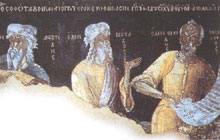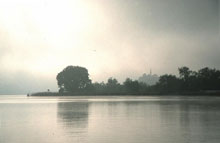 |
| The islet is a traditional settlement that has
not changed even if compared with the description of the Franciscan
monks. Little boats are actually connecting it with Ioannina. |
It is the quietness and calmness of the islet that the monks and hermits
sought when they arrived there and found four monasteries; this happened
after the Despotate or Principality of Epirus was found in 1204 and followed
the Capture of Constantinople by the Franks. In the centuries that followed
more monasteries were built thus becoming eight in whole. The Ottomans
actually called it the “Island of the Infidels”.
The first ever, verified testimony to the monastic settlement is the date
1292 that is inscribed on the lintel of the Filanthropino’s Monastery.
Based on the remains of the churches one can notice the simple architectural
form of the buildings which were mostly basilicas. An exception to this
rule is the Monastery Diliou the form of structure of which is directly
related with that of the 12th century. The three monasteries of Filanthropino,
Diliou and Eleousas are unique for their exquisite murals distinct in the
history of ecclesiastical wall painting of the medieval era in Epirus.
 |
| Aristotle, Plutarch and Thucydides from a mural
in Filanthropino Monastery. |
The lake and the islet have been connected with certain events that stand
out in history. In 1434, four years after the Ottomans took over Ioannina,
Durahan Pasha arrived at the lake and it was a cold winter; the lake was
covered with ice and snow and without knowing it Durahan had his whole
army cross it. The next day, when he found out what had actually happened
he built at the edge of the lake a Monastery, Panagia Durahani, which stands
to this day. What’s more, in this lake, Kyra Frosyni, the object of desire
of Muhtar, son of Ali Pasha, the Ottoman ruler, was drowned along with
17 other maidens, after the latter, influenced by his son’s wife, gave
this vicious order, in 1801. W. Leak, who visited the island in 1809 notes:
There were only a few monks at the monasteries as the latter are used
by the vizier to accommodate for the prisoners who have been incarcerated
here from every corner of his dominance. Eleousa, the biggest monastery
of all, is inhabited by the women and the children of the men of Souli
who have escaped here from the Ionian Islands. (The people of Souli abandoned
their homeland, Souli, in 1803.) These poor creatures have only a loaf
of stale bread to eat each day and are depending on the kindness of the
islet’s inhabitants.
The French Consul Francois Pouqueville writes the following about the
islet (in 1810):
About two-thirds of the length of the lake, from the southern or upper
end, and nearer to the east than the west side, rises up an island of
an uneven rugged surface, having at the north end a Greek village of
eighty houses, inhabited by fishers and watermen. On the eminences, and
in the hollows of this island, are seven chapels styled monasteries,
of which the most remarkable is converted into a state-prison, and becomes
the scene of the secret executions of those persons whom tyranny finds
it necessary to remove from the world. Towards the south end of the island,
which presents a perpendicular cliff on the east, are a few green and
corn fields. At the opposite extremity the Janinotes assemble in summer,
to amuse themselves and get a little more than merry. [F.C.H.L. Pouqueville
(London: Printed for Sir Richard Phillips and Co, 1820).]
In 1825, Louis Dupre, going through Ioannina writes in his book Voyage
a Athenes et a Constantinopole:
I walked downwards, towards the lake, and there in an islet that rises
on its south, I discovered a beautiful village in which I counted 7 monasteries.
Opposite of the village, where there is something like a cape, and on
it the castle and the old Palace are easily discernible. No matter where
I turned my glance, it rested with pleasure: there where the fishing
boats and then the wild birds who flew so vividly and swiftly bringing
thus the whole scene to life. It seemed difficult too manage to escape
from this wonderful scenery, to which I had my eyes feasting so that
I could paint the palace and the caste.
The troops of the Sultan arrived after his direct order in 1821 in order
to bring down the rebellious Ali Pasha, held Ioannina under siege and
then destroyed the islet with their wrath. Ananias, the abbot of Pantokratoras
Monastery describes:
The islet was enslaved because of Ali Pasha and the monasteries were
dismantled to stone and holy brassware were looted and the monks were
slaughtered and the rest of us were taken slaves. Resit Pasha took 150
piastres and then he let us go and so we came back to the monasteries.
One year later, in 1822, the islet was linked in peoples’ minds with
the annihilation of Ali Pasha. The latter, along with Lady Vassiliki
and his trustees found refugee in the Pantokratoras Monastery, awaiting
absolution by the sultan, which was not granted and so his head was transported
to the court of the Sultan in Constantinople.
 |
 |
| The attractive side of Ioannina |
| |